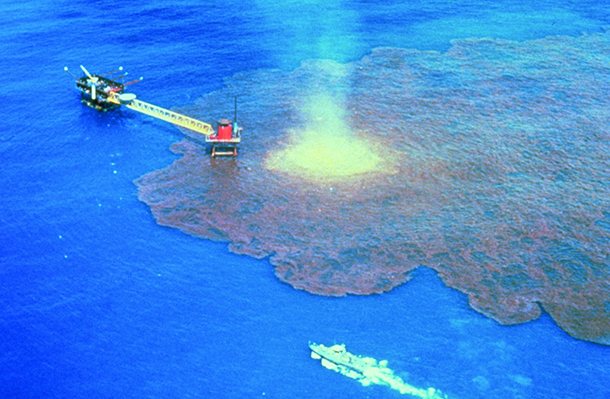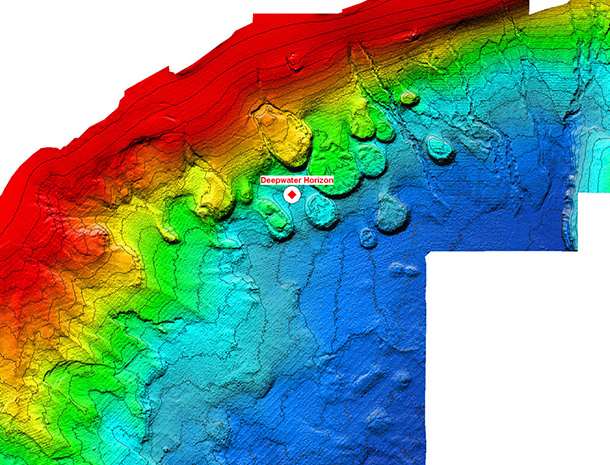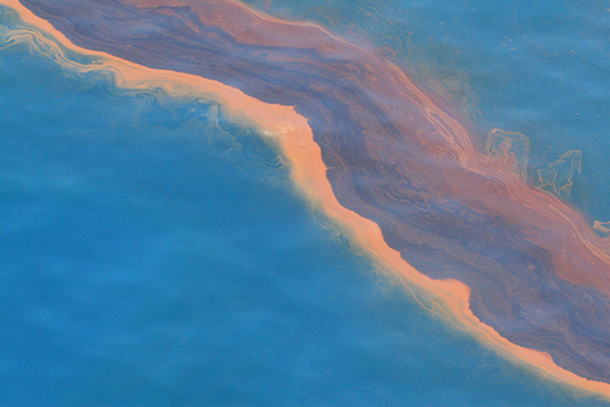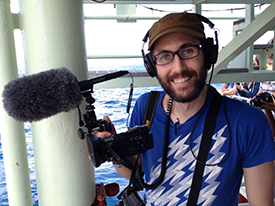Lessons From Mexico About the Deepwater Horizon Disaster
Air Date: Week of March 17, 2017

The Ixtoc blowout (Photo: Collection of Doug Helton, NOAA/NOS/ORR, Flickr CC BY 2.0)
In 1979, the Ixtoc oil well blew out off the coast of Mexico – and an oil slick spread in the Gulf over the next nine months. When the Deepwater Horizon blowout happened in 2010, with its ensuing millions of gallons of oil released, scientists noted striking similarities to the Ixtoc spill. And now -- as David Levin Reports -- ocean floor expeditions near the Ixtoc site seek to find out how the ocean is recovering three decades out, hoping to shed light on the future of Deepwater Horizon.
Transcript
CURWOOD: Nearly seven years ago the Deepwater Horizon blowout fouled the Gulf of Mexico with about five million barrels of oil. There are still traces of oil on beaches and on the seabed, and the long-term effects are hard to predict. But scientists for C-IMAGE, the Center for Integrated Modeling and Analyis of the Gulf Ecosystem, are getting a glimpse of what’s to come by studying another major oil spill. This one happened 35 years ago, off the coast of the Yucatan peninsula, and it’s giving researchers a window into the future of the Gulf. David Levin has our story.
[TRAFFIC AND STREET SOUNDS IN CUIDAD DEL CARMEN]
LEVIN: It’s late afternoon in Mexico’s Ciudad del Carmen, and rush hour’s already started. Thick traffic like this is sort of a new thing here. For most of its history, Carmen was just a sleepy fishing town. But that was before the 1970s, when the Mexican government found oil nearby. Over the last four decades, oil has transformed Carmen into a city of more than 160 thousand people. But that growth started with trouble.
News Report 1: A burning offshore oil well is dumping 30,000 barrels of crude each day into the Gulf...
News Report 2: There is now a distinct possibility that oil spilling from that runaway Mexican well could spread as far as the Gulf coast of Florida, that from an official of the EPA...
LEVIN: In June, 1979, just 15 miles offshore from Carmen, a well platform called Ixtoc 1 blew out in 150 feet of water. It caused one of the biggest spills ever to hit the Gulf, and for more than nine months, crews couldn’t plug the leak. The resulting oil slick stretched for hundreds of miles, washing up on beaches from the Yucatan to Texas.
FARRINGTON: I believe my exclamation at the time was “what an unholy mess”.
LEVIN: John Farrington is the Dean Emeritus at the Woods Hole Oceanographic Institution. When oil started coming ashore, the US government sent him and a team of researchers to study the source of the spill. They spent the next two weeks gathering samples off the coast of Ciudad del Carmen.
FARRINGTON: There was a lot of oil going into the water, that’s pretty clear, a lot of oil and gas, so we had an idea that this was very large spill, there was no doubt about it. We didn’t have any good sense of what the impact was on the shoreline other than the oil and tar coming ashore on the coast of Texas.

Because the Deepwater Horizon well is at the bottom of a marine canyon, some effects on its underwater landscape could be comparable to those of the spill at the Ixtoc well, which was perched on the edge of a marine canyon. (Photo: NOAA Office of Coast Survey)
LEVIN: The U.S. team wanted to measure that impact. They wanted to know how the oil was affecting marine life and how fast it would degrade. But before they could finish their cruise, a series of powerful storms crashed into the Texas coast. It washed the oil right off the beaches and cut the team’s work short.
TUNNELL: To the unaided eye, someone could go out there and say, “Well, all the oil is gone.”
LEVIN: Wes Tunnell is a marine biologist at the Harte Research Institute. He was part of the team studying Ixtoc in 1979.
TUNNELL: So word got around that the storms had cleaned the beaches and that currents had reversed and sent oil back to Mexico. And so the funding for all our research basically ended when that word got back to Washington.
LEVIN: Again, John Farrington.
FARRINGTON: A lot more could have been learned, but was not learned, because of a decision made, that it was a Mexican spill, and that was the end of it.
LEVIN: So, Farrington’s team packed up and sailed back to U.S. waters, and American involvement in the spill stopped. A few Mexican teams made sporadic studies over the next few years, but their reports haven’t been widely available outside the country. And Ixtoc more or less faded into memory. Until 2010.
News clip #1: 126 workers were doing routine drilling on the oil platform before it was engulfed by smoke and flames.
News clip #2: “I woke up and then I heard an explosion. I just heard a loud boom.”
News clip #3: It was the first in a series of explosions that set the rig aflame, claiming 11 lives...
LEVIN: Thirty one years after Ixtoc, the Deepwater Horizon blowout dumped millions of barrels of oil into the northern Gulf. The spill lasted almost four months. And although it was slightly larger than Ixtoc, the two disasters were eerily similar. Both were underwater blowouts. Both happened just offshore. And both left huge amounts of oil in the water. Even the shape of the ocean floor below each site is sort of the same.
MURAWSKI: The Ixtoc site is perched on the edge of a marine canyon, like Deepwater Horizon is. Deepwater Horizon was at the bottom of a marine canyon.
LEVIN: Steve Murawski is one of the lead scientists for C-IMAGE, an international team of researchers studying the effects of Deepwater Horizon. He says all the research on the recent spill is only telling scientists how oil is affecting the environment right now. It’s way harder to predict what the impact will be in the future. But since Ixtoc’s so similar, and it happened 35 years ago, he thinks returning to the Mexican site now could tell scientists what to expect near the Deepwater Horizon in the years ahead.
Wes Tunnel joined Murawski’s team to finish the work he started in the 70s. He says that studying Ixtoc today is like stepping into a time machine.
TUNNELL: So it was kind of a “back to the future” kind of thinking. Could we go down there and find any remnants of oil or beyond that, any effect or impact to the environment that might be used to look at the Deepwater Horizon spill and think forward then 30 years.

A heavy band of crude oil from the Deepwater Horizon disaster, May 12th 2010. (Photo: Deepwater Horizon Response Image Gallery, NOAA)
LEVIN: Right now the C-Image team is planning a series of research cruises near the Ixtoc well. They’re using both American and Mexican ships, and for the first time in three decades they’ll be collaborating with Mexican scientists. Together, the international teams will study marine life and sediments on the ocean floor, looking to see whether the ecosystem has bounced back, and, if so, how.
MURAWSKI: When we envisioned this, we envisioned it as a true partnership.
LEVIN: Again, Steve Murawski.
MURAWSKI: Clearly the oceanography and animals in the Gulf of Mexico don’t respect indicidual boundaries between the United States and Mexico. These are political boundaries, not real boundaries, so we should take advantage of the opportunity to create a “one gulf” look at the ecosystem.
LEVIN: It’s a goal that Joel Ortega-Ortiz supports. He trained as a marine biologist in Mexico, and spent time in Ciudad del Carmen as a grad student. Today, he works closely with Murawski at the University of South Florida.
ORTEGA-ORTIZ: The Gulf of Mexico is a shared basin. It’s a large marine ecosystem, and I think everybody understands that the more comprehensive studies that we can do, which obviously will require collaboration, the better that we’ll be able to understand the ecosystem of the Gulf of Mexico.
LEVIN: Ortega-Ortiz grew up seeing the effects of the spill, but he also grew up with the economic bonanza all that oil caused in southern Mexico. He thinks looking at the aftermath of oil spills is an essential way to understand an old and delicate balance in the Gulf. Oil wells like Ixtoc or Deepwater Horizon can inject money into coastal communities, but that same oil can also devastate fisheries and destroy key parts of the ecosystem.
ORTEGA-ORTIZ: We benefit from natural resources, but the use that we make of them comes with risks. I think we will be able to get a more objective image of what’s going on in the environment after this accident and learn so we are better prepared for next one. And there will be next one.

Reporter David Levin at work. (Photo: David Levin)
LEVIN: Today, the C-IMAGE team and their Mexican counterparts are combing through the samples they took at sea, and have started to analyze them in the lab. They’ve already seen some similarities to Deepwater Horizon. Sediment cores taken at Ixtoc show a thick layer of oil and mud that sank to the bottom during that spill, killing off tiny animals low on the food chain. At the time, it wasn’t a pretty picture. But just above those layers, fresh mud slowly starts to reappear, and new within seven years, so do new animals. A decade after the spill, the ecosystem seemed to be back to normal. And that’s a lesson that has Murawski hopeful for the area around Deepwater Horizon. The Gulf’s past, it seems, has a lot to say about its future.
LEVIN: For Living on Earth, I’m David Levin.
Links
NOAA Office of Response and Restoration: Deepwater Horizon Oil Spill
Living on Earth wants to hear from you!
Living on Earth
62 Calef Highway, Suite 212
Lee, NH 03861
Telephone: 617-287-4121
E-mail: comments@loe.org
Newsletter [Click here]
Donate to Living on Earth!
Living on Earth is an independent media program and relies entirely on contributions from listeners and institutions supporting public service. Please donate now to preserve an independent environmental voice.
NewsletterLiving on Earth offers a weekly delivery of the show's rundown to your mailbox. Sign up for our newsletter today!
 Sailors For The Sea: Be the change you want to sea.
Sailors For The Sea: Be the change you want to sea.
 The Grantham Foundation for the Protection of the Environment: Committed to protecting and improving the health of the global environment.
The Grantham Foundation for the Protection of the Environment: Committed to protecting and improving the health of the global environment.
 Contribute to Living on Earth and receive, as our gift to you, an archival print of one of Mark Seth Lender's extraordinary wildlife photographs. Follow the link to see Mark's current collection of photographs.
Contribute to Living on Earth and receive, as our gift to you, an archival print of one of Mark Seth Lender's extraordinary wildlife photographs. Follow the link to see Mark's current collection of photographs.
 Buy a signed copy of Mark Seth Lender's book Smeagull the Seagull & support Living on Earth
Buy a signed copy of Mark Seth Lender's book Smeagull the Seagull & support Living on Earth

